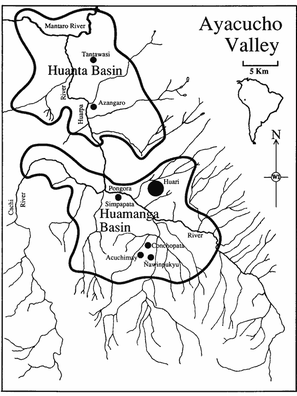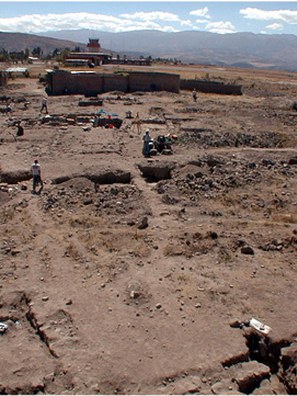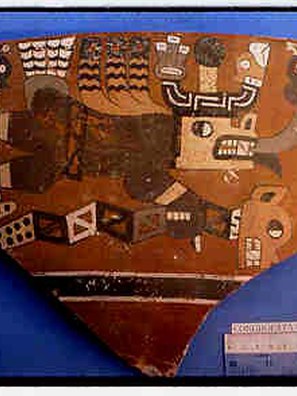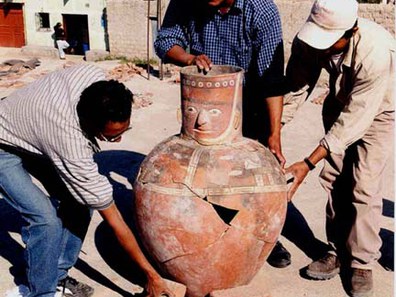
The origins of the Huari Empire may be traced to the Huarpa confederacy that occupied a vast area extending from the central highland Ayacucho basin into the neighboring Huanta Basin during the Early Intermediate Period (ca. 200 BC–AD 600). Archaeological excavation has shown that Huarpa settlements frequently underlie Huari occupation levels, both at the capital of Huari and at other settlements in the region. Because Huari most likely colonized and negotiated political arrangements with areas that it conquered or annexed, certain areas appear to have served as provincial administration centers, boasting the recognizable stylistic signatures of Huari orthogonal architecture and imperial pottery.
Below the colonial architecture of the city of Ayacucho lie the remains of the Huari period site of Conchopata, the only known Middle Horizon site in the valley, and where two spectacular caches of broken, oversized ceramic offerings have been found. While a small portion of this important site survives, it is threatened with imminent destruction by urban sprawl and housing development in the surrounding area. Excavated in 1998 by our Peruvian collaborator, José Ochatoma, Conchopata revealed one of the best-preserved D-shaped structures in the southern Ayacucho Valley. Unfortunately, this significant archaeological discovery was bulldozed by landowners in December 1998, along with several other structures that had been cleared in excavations. The National Institute of Culture, along with the Universidad Nacional San Cristobal de Huamanga in Ayacucho, invited our collaboration in attempts to protect the site. The urgent salvage excavation of Conchopata, funded by a Dumbarton Oaks Project Grant and support from the National Geographic Society, involved an intensive campaign of surface clearing, mapping, and excavation to save the architectural core of the site (Sector B), which was most threatened.
Excavations at Conchopata

Conchopata received recognition earlier this century, when Peruvian archaeologist Julio C. Tello excavated a magnificent cache of broken ceramic urns covered with Huari figural iconography. Many previous efforts to preserve the site met with only partial success, but the recovery of a second cache of broken painted pottery placed Conchopata on the archaeological map. Once reconstructed, these pottery pieces formed a set of huge anthropomorphic jars, with figures dressed in tunics featuring Huari iconography, including that of the Tiwanaku Gateway of the Sun. Significantly, these vessels were produced in Conchopata, and abundant debris associated with intensive ceramic production has surfaced in almost every excavation unit. The ceramic artifacts and associated designs, style diversity and iconography indicate that this was a major medium of symbolic communication and a rich source of information recorded as unspoken visual art. Such evidence found at Conchopata allows reconsideration of the unresolved and widely discussed question of how figural iconography became the main repertoire of figures shared with Tiwanaku. On a grander scale we are also exploring how Conchopata might contribute to understanding the autochthonous urban trajectory that also lay the groundwork for the emergence of the city of Huari just 12 km to the north.
The architectural core of Conchopata can be divided into several distinct areas. To the north and northeast we cleared open plazas containing floors spread with oversized, broken decorated pottery, as well as a mortuary area composed of agglutinated rectangular rooms with a variety of subfloor burials, and surrounding architecture that contained little domestic refuse. This area may have had a civic use or possibly served as an elite residence. The most important finds expand our understanding of Huari period architecture and ceramics production. Excavations at Conchopata have uncovered a new urn iconography that is not derived from the larger pantheon shared with Tiwanaku, but rather represents a repertoire of Ayacucho figures related to the emergence of political elites and warriors depicted on feasting vessels. We have also discovered an elite mortuary precinct that contained a house model and the earliest known highland chonta wood archer's bow with incised designs, as well as other architectural structures.
Painted ceramic fragment from Conchopata

One of the principal objectives of our research was to focus attention on the area where the previous ceramic caches were found, in order to clarify the contexts, spatial relationships, and larger architectural spaces within which ceramic production took place. Burials containing pottery that dates to the late Huarpa period and early Middle Horizon Epoch 1 were cut into bedrock and situated below a meter of deposits with oversized urn fragments richly decorated in a new iconography of human heads. The urns illustrate as many as seven distinct headdresses and facial decorations displayed in a band below the rim. Remarkably, these broken urn fragments were found just meters from where the broken, oversized face-neck jars were originally excavated. Only a few meters east of this area was another open plaza containing a dense dispersal of oversized painted and plain urns identical to those found at Conchopata by Tello in 1942. It is therefore most likely that this is where the Tello offering was originally excavated. The specialized artisans who were commissioned to produce these spectacular oversized vessels were important members of society, residing close to where the temple, civic, and mortuary areas are located.

Worthy of special attention are several finds from within a mortuary compound that consists of a series of agglutinated rooms. This area was used repeatedly, over several generations as witnessed by visible remodeling, wall extensions, and replastering events. Different burial patterns are evident. One form, which recurs at Huari and can now be considered typical of the period, consists of cylindrical shaft tombs, with perforated stone-capped cists. The holes would have been used to reopen the chambers for newly deceased individuals and functioned as orifices for libations and other offerings. At Conchopata a small rectangular room with finely plastered walls was constructed to enclose the cut stone-capped cist that contained human remains, tupus, turquoise artifacts, and a beautifully painted architectural model, the first known from a Huari site. Two rooms away within the mortuary precinct, another type of burial was encountered below the floor in a chamber cut into bedrock. The remains of several individuals were found. Bones were shoved to the back of the cavity to make room for the last two individuals placed in the tomb along with ceramic vessels and other artifacts. One of these individuals, interpreted to be a male, was associated with two incised wooden chonta fragments, one of which was part of an archer's bow. The other individual was possibly female and associated with copper tupus (metal pins). The architecture at Conchopata has a long history that includes several complex rebuilding phases dating from the end of the Early Intermediate Period to the Middle Horizon.
How and when was space used at Conchopata? The room excavations and mapping conducted between June and August 1999 raise numerous questions and also seem to indicate that all sectors of the site were not occupied simultaneously. Some areas experienced multiple rebuilding events while others did not. Most of the architecture consists of rectilinear structures, with the exception of three circular buildings. Two are clearly D-shaped structures with evidence of ritual activities in the form of subfloor offerings as well as pottery smashes, as revealed in the 1998 excavations conducted by Jose Ochatoma and Martha Cabrera. A similar structure, Vegachayoq Moqo at Huari, is called a temple. D-shaped buildings, once only known from Huari and Conchopata, are now recognized at many highland Huari sites. They were used in different ways: some are found full of ash, others with offerings, some are clean and still others were used for mortuary purposes at the time of their abandonment. Differences in their design (wall height, presence or absence of niches), frequency, and orientation are being studied.
In the final days of our excavations we cleared the partial remains of an older circular building that may also have been originally D-shaped. Three such buildings exist at Conchopata, and they are not contemporary. Was each Conchopata ruler and his/her lineage responsible for building their own D-shaped structure? Might these buildings be Huari ushnus? Their rounded walls are not unique, but rather are part of a long Andean tradition that commences in the late Preceramic and culminates with Inca architecture. The observatories at Inca sites are also among the only buildings with round walls. While more thorough analysis lies ahead, it is certain that the beautifully painted, oversized pottery from Conchopata is found in distinct contexts, sealed in subterranean unprepared cists, included as dedicatory events when rooms were sealed, and utilized as part of floor smash events that most likely were associated with abandonment activities and the sealing of sacralized spaces such as D-shaped structures.
Conchopata is undoubtedly the major center that dominated the cultural landscape in the southern Ayacucho Valley during the Middle Horizon. This important site indicates that during the early years of Huari, there were two sister centers, one at each end of the valley. Research at Conchopata and its relationship to nearby sites, such as Ñawinpuquio and Acuchimay, should clarify whether these "individual" sites were actually part of a "Greater Conchopata" settlement. If the D-shaped structures that are characterized by cardinal directionality were also used as astronomical observatories, then their location at both extremes of the Ayacucho Valley and at high points where the horizon is visible presents a new perspective on how these sites formed part of a large emerging valleywide polity that expanded territorially into the first known Andean empire.
Selected References
Anders, Martha
n.d. Dual Organization and Calendars Inferred from the Planned Site of Azangaro: Wari Administrative Strategies. Doctoral dissertation, Cornell University, 1986.
Benavides, Mario
n.d. Estudio de la cerámica decorada de Qonchopata. Bachelor's thesis, Universidad Nacional San Cristobal de Huamanga, Ayacucho, Peru, 1965.
Cook, Anita
1987 The Middle Horizon Ceramic Offerings from Conchopata. Ñawpa Pacha 22–23: 49–90. Institute of Andean Studies, Berkeley.
1994 Wari y Tiwanaku: entre el estilo y la imagen. Pontificia Universidad Católica del Peru, Lima.
n.d. Huari D-shaped Structures, Sacrificial Offerings and Divine Kingship. In Ritual Sacrifice in Ancient Peru: New Discoveries and Interpretations (Betty Benson and Anita Cook, eds.). University of Texas Press, Austin (in press).
Isbell, W. H., and A. Cook
1987 Ideological Origins of an Andean Conquest State. Archaeology 40(4):27–33.
Isbell, W. H., and Gordon McEwan (eds.)
1991 Huari Administrative Structure: Prehistoric Monumental Architecture and State Government. Dumbarton Oaks, Washington, D.C.
Knobloch, Patricia
n.d. A Study of Andean Huari Ceramics from the Early Intermediate Period of the Middle Horizon Epoch 1. Doctoral dissertation, State University of New York, 1983.
Lumbreras, Luis
1974 The Peoples and Cultures of Ancient Peru. Smithsonian Institution Press, Washington, D.C.
1975 Las Fundaciones de Humanga. Editorial Nueva Educación, Lima.
McEwan, Gordon
1996 Archaeological Investigations at Pikillacta, a Wari site in Peru. Journal of Field Archaeology 23(2):169–186.
Meddens, Frank, and Anita G. Cook
n.d. Huari Administration and the Cult of the Dead Yako D-shaped Structures in the South Central Highlands. In Wari el Primer Estado Imperial Andino. (Luis Millones and Enrique González Carré, eds.). El Monte, Seville, Spain.
Menzel, Dorothy
1964 Style and Time in the Middle Horizon. Ñawpa Pacha 2:1–105. Institute of Andean Studies, Berkeley.
Ochatoma, José Paravicino, and I. Perez Calderon 1998 Conchopata. Revista de Arqueología 1. Universidad Nacional San Cristóbal de Humanga, Ayacucho, Peru.
Paulsen, Allison
1983 Huaca del Loro Revisited: The Nasca-Huarpa Connection. In Investigations of the Andean Past. (D. H. Sandweiss, ed.): 98–121. Cornell University Press, Ithaca.
Pozzi-Escot, Denise
1991 Conchopata: A Community of Potters. In Huari Administrative Structure and State Government (W. H. Isbell and G. McEwan, eds.): 81–92. Dumbarton Oaks, Washington, D.C.
Schreiber, Katharina
1992 Wari Imperialism in Middle Horizon Peru. University of Michigan, Ann Arbor.
